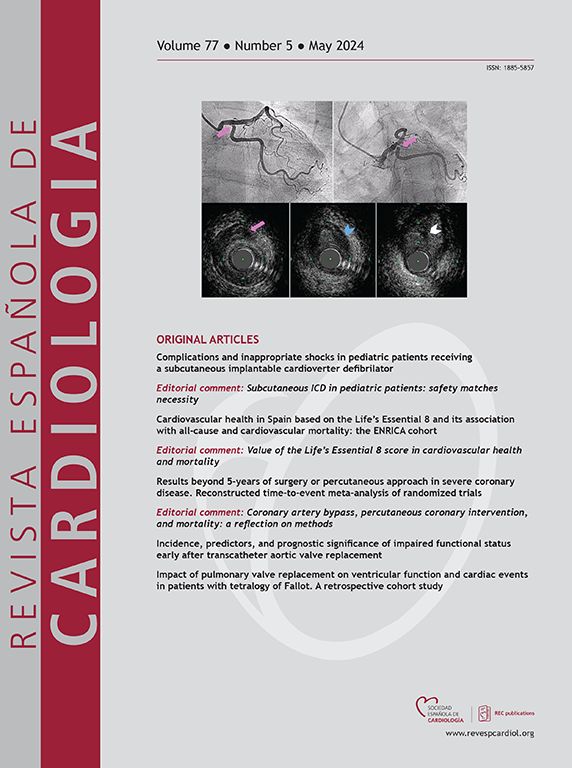Reparación de borde a borde de la válvula tricúspide y hospitalizaciones por insuficiencia cardiaca: registro TRI-SPA
IF 5.9
2区 医学
Q2 Medicine
引用次数: 0
Abstract
Introduction and objectives
The prognostic impact of a history of heart failure hospitalizations (HFH) in patients undergoing transcatheter tricuspid edge-to-edge repair (T-TEER) has been scarcely studied. This study presents the results of the TRI-SPA registry, which includes data from 15 Spanish centers.
Methods
A multicenter, retrospective registry was conducted, including patients who underwent T-TEER between June 2020 and May 2023. Patients were classified into the 3 groups, based on the number of HFH in the 12 months prior to the procedure: no HFH, 1 HFH, and > 1 HFH (recurrent). The primary endpoint was all-cause mortality and HFH.
Results
Of the 262 patients included, 167 (63.7%) had no history of HFH, 60 (22.9%) had 1 HFH, and 35 (13.4%) had > 1 HFH. Patients with > 1 hospitalization had more comorbidities, higher surgical risk, and worse functional class; however, no significant differences were observed in the severity of tricuspid regurgitation either at baseline or after T-TEER. After a median follow-up of 365 [160-643] days, patients with recurrent HFH had higher rates of the composite outcome (9.9%, 16.7%, and 43.1%, respectively; P < .001), as well as higher mortality rates (P = .036) and HFH (P < .001). The number of HFH significantly decreased in the 12 months following T-TEER compared with the 12 months prior (P = .001).
Conclusions
Recurrent HFH within the 12 months prior to the procedure was associated with a higher risk of adverse clinical events during follow-up. T-TEER significantly reduced the number of hospitalizations during the follow-up period.
三尖瓣边缘修复和心力衰竭住院:TRI-SPA登记
前言和目的在接受经导管三尖瓣边缘到边缘修复(T-TEER)的患者中,心力衰竭住院史(HFH)对预后的影响几乎没有研究。本研究展示了TRI-SPA登记的结果,其中包括来自15个西班牙中心的数据。方法采用多中心回顾性登记方法,纳入2020年6月至2023年5月期间接受T-TEER治疗的患者。根据术前12个月内HFH的发生次数将患者分为3组:无HFH、1次HFH和1次HFH(复发)。主要终点是全因死亡率和HFH。结果262例患者中167例(63.7%)无HFH病史,60例(22.9%)有1次HFH病史,35例(13.4%)有1次HFH病史。住院1次的患者合并症较多,手术风险较高,功能分级较差;然而,无论在基线还是T-TEER后,三尖瓣反流的严重程度都没有观察到显著差异。中位随访365天[160-643]天后,复发HFH患者的复合结局发生率更高(分别为9.9%、16.7%和43.1%,P < 0.001),死亡率(P = 0.036)和HFH (P < 0.001)。与前12个月相比,T-TEER后12个月内HFH数量显著减少(P = .001)。结论手术前12个月内复发的HFH与随访期间不良临床事件的高风险相关。T-TEER在随访期间显著降低了住院次数。
本文章由计算机程序翻译,如有差异,请以英文原文为准。
求助全文
约1分钟内获得全文
求助全文
来源期刊

Revista espanola de cardiologia
医学-心血管系统
CiteScore
4.20
自引率
13.60%
发文量
257
审稿时长
28 days
期刊介绍:
Revista Española de Cardiología, Revista bilingüe científica internacional, dedicada a las enfermedades cardiovasculares, es la publicación oficial de la Sociedad Española de Cardiología.
 求助内容:
求助内容: 应助结果提醒方式:
应助结果提醒方式:


